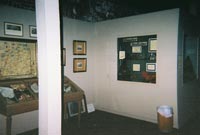|

THE CITY OF INDEPENDENCE'S RICH HISTORY
Independence, Missouri, lies on the south bank of the Missouri River, near the
western edge of the state and a few miles east of Kansas City. Few towns its size can claim such a rich history.
The Missouri and Osage Indians originally claimed the area, followed by the Spanish and a brief French tenure.
It became American territory with the Louisiana Purchase in 1803.
Independence was the second settlement in Jackson County and was chosen as the county seat in 1826. From 1841 to
1849, Independence was known as the Queen City of the Trails as goods and services were provided for travelers
beginning their long journey on the Santa Fe, California and Oregon trails.
In the 1840s, the cities of Independence, Westport, and Kansas City merged into the great city of Centropolis,
envisioned as the dominant metropolis of the area, much like Chicago or St. Louis. Today, Westport is part of Kansas
City and Independence is its largest suburb.
THE 1859 JACKSON COUNTY JAIL
The old jail was built in 1859 at the same time as the Sheriff's House.
The jail has six cells down stairs, and six more up stairs. There used to be an iron staircase to the second floor.
The two-foot-thick walls are made of limestone blocks, some of which are six feet long. Each cell has a grated
iron door and a solid iron door. Not much light came through the iron shutters covering the windows covering the
windows during the day. There was no glass so the wind could blow through. |
|
 |
At night, a kerosene lamp was lit in the hall. During the Civil War, there were
as many as 20 prisoners placed in each cell. The cells are only six-by-nine-feet and are made to hold three prisoners.
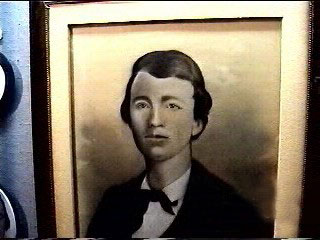 |
|
PRISONERS OVER THE YEARS
Prior to the Civil War, with the hostilities provoked by the slavery issue, marshals were confronted with keeping
law and order in the midst of guerilla raids from both Kansas and Missouri. William Clark Quantrill, leader of
a pro-Confederate guerilla band, was once arrested and put in the 1859 Jackson County Jail. Under influence from
Quantrill's friends, he was released. The marshal claimed he had never truly arrested Quantrill but had taken him
into protective custody. |
When the Union garrison occupied the Jail, they demanded loyalty oaths of the citizens. Citizens who refused the
loyalty oath, or refused to disclose the whereabouts of sons or father, were imprisoned in the Jail. After the
2nd battle of Independence in 1862, the cells were so packed with prisoners that there was no room to lie down.
| Another famous occupant of the 1859 Jackson County Jail was Frank James, brother
of Jesse James. Obviously, receiving great sympathy for his southern leanings, this famous accused bank and train
robber and murderer was accorded deluxe treatment. His cell had a Brussels carpet, fine furniture and paintings.
Frank was allowed to leave his cell and visit freely with other inmates. Card games were a nightly affair in James'
sumptuous cell. |
|
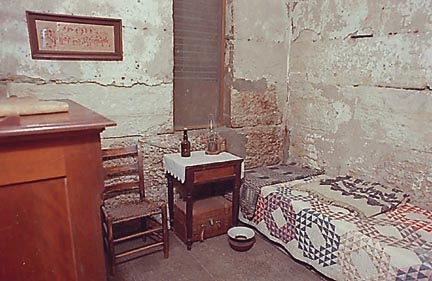 |
Frank James was held in the Jail for the crime of murder. He was acquitted and lived the rest of his life in the
area.
Prior to the Civil War, a person could be given a jail sentence for one of the following crimes: Horse racing on
public streets, firing guns in town, operating a gaming house, assault and battery, disturbing the peace, disturbing
a religious meeting, or building a privy "not over a pit."
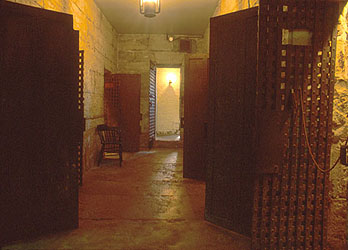 |
|
THE WAR BEFORE THE WAR
With the passage of the Kansas-Nebraska Act in 1854, Kansas, Missouri's neighbor to the west, was given the choice
of entering the Union as a slave or free state. Kansas elected to be a free state. Missouri and Kansas were not
good neighbors. Constant border clashes between pro-slave Missourians and free-state Kansans brought war to Jackson
County five years before the official declaration in 1861. |
The burning of homes, looting of property and retaliatory killing of slavery supporters
and abolitionists caused indescribable suffering to the average Jackson County citizen. Priscilla Jackson Evans
wrote, "It was in this environment that the old Jail was built. Never was a building more symbolic of a community's
desperate attempt to control disorder and violence, and of its attitude toward those who acted outside the law."
In 1861, a Union garrison occupied the old Jail, using it as a headquarters for the Provost Marshal. Southern sympathies
were strong in Eastern Jackson County. Any citizen who voiced those sympathies could expect to spend time in the
Jail.
In Jackson County, the Battles of Independence and Lone Jack in 1862 ended in Confederate
victories. The state of Missouri was held in the union by military force even though the elected Governor and legislators
had voted to secede from the Union. In Jackson County old grudges erupted between families and neighbor turned
against neighbor. Women and children were arrested and placed in the 1859 Jail now under the command of the Union
Provost Marshals nicknamed the “Little Gods” for the power they had over the population.
When the Jail overflowed with the residents of Jackson County, other buildings were used as jails. One of those
buildings collapsed and several young girls were killed. Historians believe that this action would help motivate
Quantrill's raid on Lawrence, Kansas in 1863. |
|
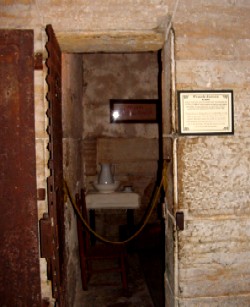 |
The attacks across the Missouri-Kansas border continued. As the guerilla raids
increased, Union forces determined to rid the area of guerrillas by depopulating the border counties so the raiders
would have no sanctuary. For General Ewing the last straw was Quantrill's raid on Lawrence, Kansas on August 19,
1863. He believed that southern sympathizers were harboring the raiders.
ORDER NUMBER 11
On August 25, 1863, Union General Thomas Ewing issues the now infamous Order Number
11, placing all outlying areas of Jackson, Bates and Cass counties under martial law. All residents in these counties
had to prove their allegiance to the Union by signing a loyalty oath.
 |
|
Those remaining loyal to the Confederacy were given 15 days to leave the area. They
could move to temporary military station sanctuaries in Missouri, or they could move to Kansas. The order was strictly
enforced. More than 20,000 people were forced to leave their homes. Homes, crops, and livestock were destroyed
or confiscated. Many families moved back to their homes in Tennessee and Kentucky to wait out the war.
The enforcement of this order resulted in terrible hardships for the residents, many women and children had to
walk to Texas or Kentucky. Some people were shot down in the act of obeying the order, both Union and Southern
families alike. Many families never returned to Jackson County after the war. Others who refused the alternatives
were incarcerated in the Jail, with as many as 20 people in a cell. Independence virtually became a refugee camp. |
George Caleb Bingham, famed Missouri artist and statesman, vented his rage at
the treatment of citizens with his rendition of "Martial Law" or "Order Number 11," painted
while he was a resident of Independence. The painting shows General Ewing driving a family from their home. Bingham
had been an outspoken critique of border wars but believed the solution Ewing sought was terribly unfair.
He later produced an engraving of the painting and sold signed, numbered copies
of “Martial Law.” One of his signed proofs is on display at the 1859 Jail, Marshal’s Home and Museum. Reproductions
are available for sale. Copies of this painting were widely distributed and were instrumental in General Ewing's
defeat when he ran for governor of Ohio, after the war.

AFTER THE WAR
Decades after the war ended in Missouri, the citizens of Jackson county felt the lingering bitterness and uncertainty
of that great conflict. Out of these tumultuous times rode Missouri’s most notorious outlaws. Outlaws like the
James boys and Youngers used the remaining animosities from the outrages of the war to stay a step ahead of the
law for nearly twenty years.
In the spring of 1882, Jesse James was murdered. His older brother, Frank, began negotiations with the Missouri
governor to surrender because he feared assassination. Frank James spent almost six months in the Jackson County
limestone jail before his acquittal on murder charges.
THE 1903 JAIL EXPANSION
The need for additional prison space in 1900 necessitated the addition of a two story brick building directly behind
the limestone Jail. This was designed to house minimum-security prisoners and was finished in 1903. Many of these
prisoners made up the "chain gangs" that worked on nearby roads and other public projects (like building
sewers).
They left six days a week at sunrise and returned at sunset. One inmate spent
a year on the chain gang for stealing a cow.One can only imagine the sight of a group of such men working under
the scrutiny of the ever-vigilant deputies. This addition now comprises the Museum exhibit area.
TIMELINE OF THE JAIL
| 1827 |
|
Independence platted and lot number two set aside for the Jail: first sheriff was
Joseph Walker, mountain man and explorer |
| |
|
|
| 1841 |
|
Second Jail built; Porter Rockwell held. |
| |
|
|
| 1859 |
|
New Jail replaces second structure: Marshal's residence is attached to the new facility. |
| |
|
|
| 1861 |
|
Civil War began; Jail used periodically by Union troops as headquarters during the
war. |
| |
|
|
| 1862 |
|
Jail under attack during the first Battle of Independence. |
| |
|
|
| 1863 |
|
Order Number 11; Jail holds as many as 20 prisoners to a cell. |
| |
|
|
| 1864 |
|
Price's Raid |
| |
|
|
| 1866 |
|
Jailer Henry Bugler shot. The Rev. A.H. Dean is jailed. George Caleb Bingham paints
his portrait. |
| |
|
|
| 1881 |
|
Bill Ryan - a James gang member - held at Jail for trial. |
| |
|
|
| 1882 |
|
Frank James surrenders and is incarcerated at 1859 Jail. |
| |
|
|
| 1880s |
|
Mother Mary Jerome Shubrick works at Jail and heralds prison reform in Missouri. |
| |
|
|
| 1890 |
|
Chain gangs leaving Jail to work on county roads are a common sight. |
| |
|
|
| 1903 |
|
Additional brick facility added to rear of Jail |
| |
|
|
| 1920 |
|
Jail closed by Judge Latshaw for inadequate facilities. |
| |
|
|
| 1921 |
|
Jail reopened on technicality. |
| |
|
|
| 1933 |
|
Jail use terminated and building used for regional relief services (WPA - Works Progress
Administration) during the Depression. |
| |
|
|
| 1945 |
|
American legion proposes to take over building for headquarters. |
| |
|
|
| 1959 |
|
Jackson County Historical Society acquires and begins to restore Jail. |
VISIT THE 1859 JACKSON COUNTY JAIL MUSEUM
The jail is now operated as a museum by the Jackson County Historical Society and is located in Independence Square
at 217 N. Main Street. Both the jail and the Marshal’s Home have been painstakingly restored. You can see the Marshal’s
home from Main Street, but the two-story limestone jail and the 1903 chain gang jail joins the rear of the home.
From March through October, you can take a self-guided tour of the jail and museum for a first hand look at frontier
justice, and then tour the beautifully decorated home where the wife and children of the marshal lived. Guided
tours are available upon request in advance. This historic site is well worth you time. Visit the 1859 Jackson
County Jail Museum website by clicking
here. |
|
 |
Recently a movie called "Shiloh Sharps" shot some scenes at the 1859
Jackson County Jail Museum, in order to take advantage of some of the most authentic looking "set pieces"
you could even find or build. Why design and build something artificial when you can shoot parts of your film in
the real thing?
-Mark Stinson
Note: Some of the written materials and images on the History and Background pages came from the following sources:
The Jackson County Historical
Society, Legends of America, The Examiner, Ghosts of the Prairie, and Missouri
Haunts...as well as interviews with Lindsey Gaston of the museum staff.
|









